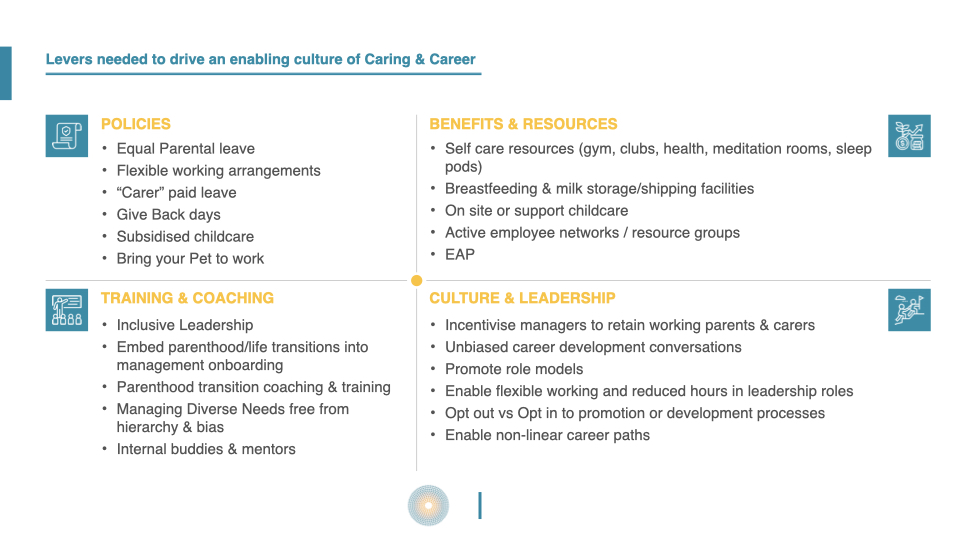What Is Driving The Increase In Parental Leave & Why We Should Pay Attention
Jul 28, 2020
Since 2020, all of us have been dealing with the impact of COVID19 on our personal and professional lives. It has dominated our whole being since March 2020. It has amplified the challenges that carers face, be it looking after children, ageing parents, disabled siblings, sick relatives... and has reminded us of the fragility of our own ecosystems.
Two weeks before we started social isolation in Switzerland, many of us were focused on the significance of International Women’s Day and bearing witness to the commitments being made by senior leaders (see our partner Advance) to advance women here in Switzerland.
However, since then, as we continue to deal with the consequences of the coronavirus, there has been a concern that Inclusion & Diversity will become lost in business recovery activities.
In fact, we have seen the opposite:
- Black Lives Matter has highlighted the continued demand and right for inclusion.
- Progressive organisations have increased the amount of time employees can give back to communities.
- Parental leave, in particular secondary carer leave, has been increased in many companies.
Nurturing cultures that enable caring and career
Given our mission at Thriving Talent to help organisations nurture cultures that enable caring and career, we want to dive deeper into parental leave.
Last month, Fidelity International announced that as of September all new parents, regardless of gender, will be entitled to six months of paid leave during the first year of their child’s birth.
The reason? 💡
To improve workplace equality absolutely, but another key driver is to stay competitive; to attract and retain a significant population of the workforce - parents! When Standard Life Aberdeen offers 9 months of paid leave and Invesco offers 6 months weeks of paid leave, other Asset Managers need to raise their game.
This month, JTI International announced a global strategy of a minimum of 20 weeks as a gender neutral benefit, as part of their gender and diversity journey. How long will it be before PMI and BAT announce changes?

In fact PMI has offered much support to new parents since we started working with them in 2016, providing quarterly workshops, coaching, training and e-learning; coupled with an inspiring voluntary 'Parents at PMI ERG.' This is greatly appreciated by new parents and managers but of course, policies will also need to stay competitive.
Professionals, often in their late 20s, start to think about who provides the best environment so that one can thrive professionally and personally - without floods of overwhelm, guilt and a caring/career crash. When competing for talent, it is an important lever to pull.
Such policy change does have a positive impact on how an organisation is perceived as an Employer of Choice and we know that it increases the number of applications for job roles posted.
Retaining talent and ensuring ROI
So, what is required to retain talent and ensure that parents not only return post a parental leave but then stay for longer than 6-12 months? How do organisations ensure they see the ROI?
How do companies ensure that if they invest in this benefit to attract and retain talent; they are not met with an additional cost (3-4 times a salary) to backfill any parents who decide to leave?
It starts with an awareness of the reality of the many challenges, fears and doubts that surface when professionals start the journey to parenthood. Of course, it is a time of much joy and celebration but it can also create great uncertainty of what impact parenthood will have on one’s career. How do we know? These fears are still shared with us today at Thriving Talent through exchanges in workshops and/or coaching programmes.
💬 “I want to “show up” and still be taken seriously but I worry that others will think less of me professionally now I am pregnant.”
💬 “I’m very happy & at the same time I’m afraid because I have seen many women’s development stopped when they become Mothers.
💬 “I worry that starting a family has impacted my career progression opportunities, as I will be perceived differently by others. I would like a career roadmap so that this is not the end of my career.”
💬 “At the beginning, I had the feeling that I was invisible and did not matter, especially when I saw projects go to others that would have come to me prior to being a parent. It was assumed I would not want to be involved due to my caregiving responsibilities.”
💬 “It feels like you need to make a choice to move off the “fast track” to the “slow track” if you want to be a hands-on Father, despite leadership aspirations.”
When we share these “voices” with managers, many are shocked. Many ask us how many years ago did we hear these voices? When we share that these are fears and challenges shared in recent weeks, there is disbelief.
Often, there is great inconsistency in the employee experience at this time - all due to the behaviour and expectations of the manager. Managers need help too, so that they feel better equipped to have the much needed conversations and effectively manage the diverse needs of diverse teams.
So, having increased your awareness, what next?
How do you react to these voices? What do you need to pay attention to, to engage and retain parents?
Think holistically. Consider the whole ecosystem and whether that supports parents and all employees to manage life transitions with flexibility and hope.

We are often asked, what are the top 3 levers if we had to prioritise, for the maximum positive impact on retention and engagement of parents?
- Enabling policies: a minimum of 5 months paid equal parental leave & flexible working.
- Provide emotional and practical support to help parents navigate the transition to parenthood, especially when working far from the extended family.
- Educate and equip Managers on the significant role they play in the retention of parents, from the moment they hear the news through to career conversations post parental leave.
Ultimately, companies need to pay attention to all of the levers, in particular the importance of role models in leadership, less linear career paths and all leadership roles being posted less than 100%; if they are striving for gender parity at all levels of leadership.
We are about to publish a report on busting the myth that Leaders must work at 100% and above - make sure you're subscribed to our newsletter via the link at the bottom of this article if you want to receive it.
Now is the time to get started
Build your awareness of how employees in your organisation experience the transition to parenthood. What are their challenges, fears and assumptions? Provide immediate support to those in the transition and let this inform you. If you feel like you are pushing water uphill, look around at the competition - are they offering better policies, practices and resources?
It is incredibly easy to get started and start seeing the benefits. When one of our clients sent the invitation to over 120 new fathers to attend New Parent Workshops, the response was overwhelmingly positive - a feeling of finally being acknowledged; even if they could not attend.
To find out more, download the Working Parent Brochure to accelerate your progress or don’t hesitate to contact us directly at [email protected] if you want to organise the first interventions.
Stay connected with news and updates!
Join our mailing list to receive the latest news and updates from our team.
Don't worry, your information will not be shared.
